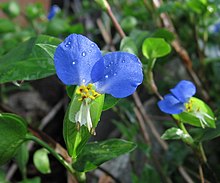Commelina communis
| Asiatic dayflower | |
|---|---|
 |
|
| Commelina communis var. ludens flowers after rain | |
| Scientific classification | |
| Kingdom: | Plantae |
| (unranked): | Angiosperms |
| (unranked): | Monocots |
| (unranked): | Commelinids |
| Order: | Commelinales |
| Family: | Commelinaceae |
| Subfamily: | Commelinoideae |
| Tribe: | Commelineae |
| Genus: | Commelina |
| Species: | C. communis |
| Binomial name | |
|
Commelina communis L. |
|
 |
|
| Green = Native, Red = Introduced | |
Commelina communis, commonly known as the Asiatic dayflower, is an herbaceous annual plant in the dayflower family. It gets its name because the blooms last for only one day. It is native throughout much of East Asia and northern parts of Southeast Asia. In China, the plant is known as yazhicao (simplified Chinese: ; traditional Chinese: 鴨跖草; pinyin: yāzhīcǎo), roughly translating to "duckfoot herb", while in Japan it is known as tsuyukusa ( tsuyukusa?), meaning "dew herb". It has also been introduced to parts of central and southeastern Europe and much of eastern North America, where it has spread to become a noxious weed. It is common in disturbed sites and in moist soil. The flowers emerge from summer through fall and are distinctive with two relatively large blue petals and one very reduced white petal.
The Asiatic dayflower plant serves as the type species for its large genus. Linnaeus picked the name Commelina in honour of the two Dutch botanists of the Commelijn family, using the two large showy petals of Commelina communis to symbolise them. Linnaeus described the species in the first edition of his landmark work, Species Plantarum, in 1753. Long before the plant was studied in Europe, however, it had been used for generations in traditional Chinese medicine. The flowers have also been used in Japan to produce a dye and a pigment that was used in many world-renowned Ukiyo-e woodcuts from the 18th and early 19th centuries. In the modern era the plant has found limited use as a model organism in the field of plant physiology due to its complex pigment chemistry and the ease of viewing its stomata.
...
Wikipedia
